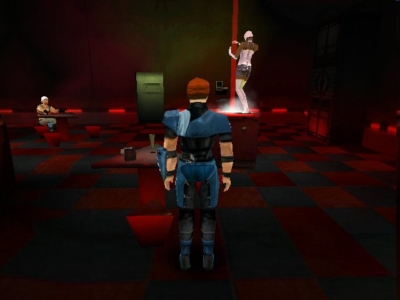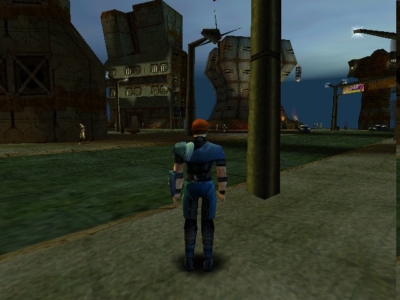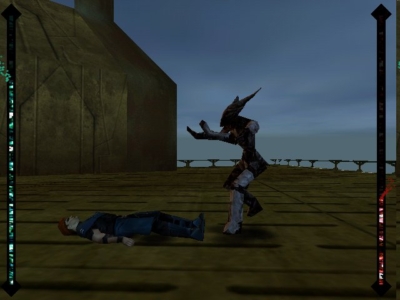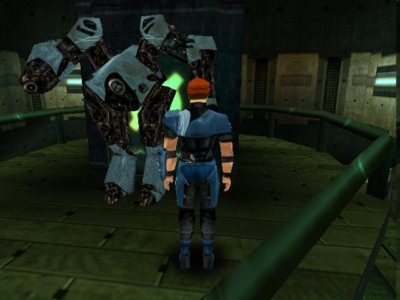
The Nomad Soul
Written by: Rik
Date posted: December 6, 2006
- Genre: Adventure
- Developed by: Quantic Dream
- Published by: Eidos
- Year released: 1999
- Our score: 5
I once read somewhere that the main difference between Star Wars and Star Trek was that if you were to mention the former to a friend-of-a-friend in a pub they would respond enthusiastically, quoting lines from the film and regaling you with tales of their own fandom, whereas if you mentioned the latter, they’d look at you as if you’d just pulled down your pants and left a turd in their pint. A bit harsh on Star Trek, maybe, but it illustrates the point that no matter how socially acceptable some sci-fi may be, there’s a whole load of other stuff out there that just, well, isn’t. The fact is, while sci-fi done well has the potential to be pretty cool, if it’s done badly, it can also end up being preposterous, laughable, and, for want of a better word, naff.
Unfortunately, The Nomad Soul is an example of naff science fiction. While it borrows a few things here and there from Hollywood (the robot enforcers are nicked straight out of Robocop) generally it feels a little amateurish. It’s like a world music version of Blade Runner, where the hardest cops wear headbands and shoulder-pads instead of a trenchcoat. More than anything else, The Nomad Soul is reminiscent of a terrible Australian sci-fi show that you might stumble across on Channel 5 on a Sunday morning in a desperate bid to avoid the Hollyoaks omnibus and The Heaven and Earth Show. God knows what it’s called – probably something along the lines of “The Tribe” – but it’s got a budget of around £10, the characters all wear “futuristic” head-bands, jewellery and make-up and they all have stupid names with apostrophes in the middle, like Sal’ektra and Mna’trath. Well, they probably do; I usually switch straight back to Hollyoaks and pour my first drink of the day.
While not many people bought it, The Nomad Soul is best known for two things, neither of which have anything to do with what I’ve just been ranting on about (which probably indicates it isn’t really all that important). Firstly, it features the acting and musical talents of eccentric Brit-rock god David Bowie (for more on this, see Wowie Zowie Bowie). Secondly, it’s an insanely ambitious game. While at first glance, the game looks like a Tomb-Raider rip-off set in a futuristic city, at it’s heart it’s an adventure game, albeit one viewed from a third-person perspective. Featuring beat-em-up and FPS sections. And with a few RPG-ey bits thrown in as well. While some bits work better than others, you certainly have to admire the developers for having the balls to have a go at creating such a multi-faceted game, especially with 1999 technology. And most people generally do, with some going so far as to declare The Nomad Soul an unfairly ignored classic worth playing today (we’ll come back to this later).
The game begins with a lumpy polygonal man beckoning you to take control of his body before something drastic happens. That man is Kay’l, a police officer from the city of Omikron, and following your inevitable acceptance of his proposal, you find yourself dumped in a back-street without much of a clue about what’s going on. However, after a bit of poking around, you find that Kay’l is in a bit of a pickle at work. After weeks on the trail of a serial killer with little much in the way of progress, Kay’l’s partner became the latest victim, after which Kay’l disappeared – which obviously doesn’t look too clever. Turn up at Kay’l’s apartment, and you’ll find his wife pretty pissed off with you (although she does seem up for a bit of hanky-panky). Go to work, and they aren’t too happy with you either. Piece by piece, you have to work out what happened to Kay’l, in between performing some of your other duties as a cop and a husband (see hanky-panky, above).
Although the “waking up in a heap of trouble with no memory of who you are” isn’t desperately original, it’s still pretty involving stuff. In fact, you start to get so attached to Kay’l and his situation, it’s a bit of a disappointment when things take a turn for the weird and you realise this isn’t a simple cop-set-up-from-the-inside kind of story. If you’re a bit thick (like me) you won’t realise that when Kay’l begs you to take control of his body, this actually means that you are the Nomad Soul of the game’s title. And if you don’t realise this, it’ll probably come as a shock to you when Kay’l eventually gets blown away and your soul gets transferred into another body. You can do that, you see. Once Kay’l’s gone, you get more and more opportunities to transfer your soul into other bodies, each with its own strengths and abilities (this is part of the RPG element I mentioned earlier).
The only trouble with this is that all of the characters you can possess are, by necessity, nothing more than a different player-model and a set of new statistics. From this point on, conversations with others are conducted in a rather anonymous fashion, which makes things a little less interesting than when you were Kay’l. Of course, by this time you’ll have met up with a bunch of weird freedom-fighter types who are always able to recognise you as the Nomad Soul. In fact, these characters increasingly try and convince you that by playing this game you, yes you – sweaty nerd-boy in boxers – have actually been transported into the game world and that you actually are involved in some inter-dimensional battle for the fate of something or other. To be honest, this is a pretty crappy concept, but again, it’s another excuse for you to not have any dialogue (or indeed personality) in the game. Would you fancy playing an adventure as the mute guy from GTA 3?
Anyway, you eventually discover that the murders in Omikron have been perpetrated by (gasp) demons. A little bit silly, perhaps, but then you’re informed that the only way to defeat demons is to engage them in hand-to-hand combat. Yep, as I mentioned earlier, The Nomad Soul has fighting bits. Encounter a demon in-game and the view suddenly switches to a Tekken-style side-on sort of thing and you start having to hammer the buttons in order to try and kick the bastard to death. At first, this seems like it might be quite good fun, until you realise that it’s bloody hard work, the controls are damned unresponsive and you’ve got no idea what you’re doing, apart from losing.
Still, at least in the fighting bits there’s a bit of a random element which could see you win by virtue of smashing all of the joypad buttons simultaneously. Plus, one way or the other, it all tends to be over with fairly quickly. The FPS sections, on the other hand, are pure torture. Not only are they technically terrible (sub-Wolfenstein, in fact worse than any FPS ever released) but they’re also bloody hard work. Even if you set the adjustable difficulty to “Easy”, the control system and level-design conspire to make you f*ck it up time and time again. Just in case you can’t tell, I’m speaking from bitter personal experience here. Just talking about it makes me angry.
Despite the silly story, the slightly disappointing effect of the soul-transfer system, and the irritating naffness of the sci-fi universe, the core of The Nomad Soul is essentially a pretty decent adventure. Unfortunately, it was ruined for me by the inclusion of some terrible sub-games which, far from being vaguely-comical diversions, are actually a fundamentally important part of the game itself. Which means that if you don’t like them, or aren’t very good at them, then you’re going to have a hard time enjoying The Nomad Soul.
What’s most frustrating is that these sections aren’t really necessary. Why not just stick to the third-person view for these sections? The excellent Indiana Jones and the Infernal Machine features plenty of combat as well as “boss” battles without deviating from the view/interface employed in the rest of the game. Even without trying to include fighting and FPS sections, The Nomad Soul would have still been an ambitious game. In fact, there are other places where it’s a victim of its own ambition – getting lost amidst the samey buildings, the brief and meaningless conversations with NPCs – but they could easily be forgiven, or put down to the technological limitations of the time (let’s not forget, this was three years before GTA went 3D).
Speaking of which, the graphics in The Nomad Soul are showing their age a little. The buildings are boxy and angular, and the player models are pretty basic, too, although it must be said that there’s quite an impressive “facial expression” system in place, with NPCs really coming to life during conversations. As always, the voice-acting varies, with some characters going at their lines with gusto, and others sounding like bored actors reading preposterous sci-fi nonsense from a sheet of paper (which, of course, they are).
The one thing you can certainly say about The Nomad Soul is that it’s quite different to a lot of other games out there. The story and “feel” of the game may not be to everyone’s taste, but in its defence it is at least quite original, as is the attempt to throw a few different genres into the mix. Unfortunately, as a game it doesn’t really hang together all that well. While you might find it interesting and even absorbing to begin with, as time wears on the game’s clunky feel, dated graphics and teeth-gnashingly irritating sub-games begin to dampen your enthusiasm, and chances are you’ll eventually get bored and start thinking about doing something else instead.






 Posts
Posts